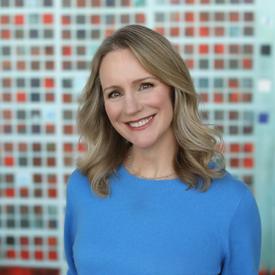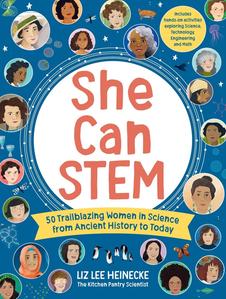
|
|
| photo: Amber Procaccini | |
Liz Lee Heinecke has an undergraduate degree in art, a master's in bacteriology, 10 years of laboratory research, and an unusual perspective as a science communicator and author. Heinecke lives in Minneapolis, Minn., where she sings, plays the banjo, and is working on a musical theater adaptation of her adult book Radiant: The Dancer, The Scientist, and a Friendship Forged in Light. Her most recent book is She Can STEM: Fifty Trailblazing Women in Science from Ancient History to Today (Quarry Books).
Handsell readers your book in 25 words or less:
She Can STEM illuminates the lives and work of 50 trailblazing women in science, from past to present, featuring projects that bring science to life.
On your nightstand now:
Although I mostly write for kids, writing about science involves history, anthropology, and culture. I draw inspiration from everything on my bookshelf.
I just finished Remarkably Bright Creatures by Shelby Van Pelt, which would be great for YA readers, and am midway through Lincoln in the Bardo by George Saunders. A Season of Migration to the North by Tayeb Salih, Crying in H Mart by Michelle Zauner, and The Bee Sting by Paul Murray are all on my nightstand, along with Wilder: How Rewilding Is Transforming Conservation and Changing the World by Millie Kerr, a finalist for the AAAS-Subaru Prize in the Young Adult Science Book category.
Favorite book when you were a child:
It's a three-way tie, with a few runners-up.
As a kid, I desperately wanted a horse but knew I would never have one, so I lived vicariously through Maureen and Paul Beebe's adventures in Misty of Chincoteague by Marguerite Henry and illustrated by Wesley Dennis.
Dragonsong by Anne McCaffrey had it all as far as I was concerned: a gifted girl who isn't allowed to be a musician because of her gender, tiny, colorful dragons called fire lizards, and a nearby planet that rained down flesh-eating parasites frequently enough to keep things exciting. I probably read it 20 times.
The Tombs of Atuan is the second book in Ursula K. Le Guin's Earthsea series and features a female protagonist who struggles against the confines of a role that's been chosen by others. Most of the story takes place in a nightmarish underground labyrinth, where Le Guin's hero Ged (Harry Potter's prototype) struggles to steal a talisman. I loved everything about it.
I was always on the lookout for books about girls on adventures. When visiting the library, I often checked out Astrid Lindgren's Pippi Longstocking books or the Danny Dunn series by Raymond Abrashkin and Jay Williams, which features a girl who loves physics.
Your top five authors:
Ursula K. Le Guin: She caught my attention as a middle-grade reader with her Earthsea fantasy series and has kept me captivated as an adult.
She uses science fiction to escape the social confines of our planet and explores themes of colonization, race, environmental destruction, political systems, gender roles, and sexuality without ever losing sight of the story. The Word for World Is Forest, The Dispossessed, and The Left Hand of Darkness are three of my favorites.
Amy Tan: I can't recall whether The Kitchen God's Wife or The Joy Luck Club was my first Amy Tan book. I adore the funny, relatable stories she tells about women and family, and enjoy learning about Chinese culture and history. The Bonesetter's Daughter, which weaves science and anthropology into the story, was fantastic too. I became an even bigger fan after hearing Tan sing with the Rock Bottom Remainders at First Avenue a few years ago.
J.R.R. Tolkien: I can't count how many times I've re-read The Lord of the Rings. I love losing myself in Middle-earth, with its mountains and languages and monsters and lore, and I've always been a sucker for a well-told hero's journey.
Margaret Atwood: Sometimes I think she can see the future. The Handmaid's Tale is a masterpiece in so many ways. I heard her speak once, and I recall her saying that she grew up reading science fiction stories with her brother. It's amazing how the books we read as children shape us as adults.
Ann Patchett: She has been one of my favorite authors for years. As a reader interested in themes of music, science, and theater, she's hit the mark over and over again with books like Bel Canto, State of Wonder, and Tom Lake. I can't wait to see what she writes next.
Book you've faked reading:
Homer's Odyssey was a college reading requirement and I never made it through. I should pick it up again. I loved Circe by Madeline Miller.

Book you're an evangelist for:
For middle-grade and high school kids who like science, The House of the Scorpion by Nancy Farmer is a great read, centered on the ethics of biotechnology. The Astonishing Life of Octavian Nothing, Traitor to the Nation, Volume I: The Pox Party by M.T. Anderson is a close second.
Book you've bought for the cover:
Beloved Beasts by Michelle Nijhuis. I'm a sucker for beautiful biological illustration.
Book you hid from your parents:
I read Forever... by Judy Blume when I was in sixth grade, I think. At that time, there were no other books like it, and everyone knew it was about teenage sex. When a neighbor girl loaned me a copy, I immediately hid it so my parents wouldn't feel the need to discuss its content with me. I read Roots by Alex Haley around the same time. That novel also contained some sex, but my parents had it sitting around the house, so it didn't feel like forbidden fruit.
Book that changed your life:
The first book I remember reading by myself was Little House in the Big Woods by Laura Ingalls Wilder. It was probably well beyond my reading level and it took me ages to get through the first page, but the fact that I recall the experience so vividly tells me how impactful it was. Struggling through that book gave me a new sense of independence and opened the door to a lifetime of reading.
Favorite line from a book:
"All things are one thing, and that one thing is all things--plankton, a shimmering phosphorescence on the sea and the spinning planets and an expanding universe, all bound together by the elastic string of time." --John Steinbeck, Sea of Cortez
Five books you'll never part with:
The Left Hand of Darkness by Ursula K. Le Guin
Dune by Frank Herbert
D'Aulaires' Book of Greek Myths by Ingri d'Aulaire and Edgar Parin d'Aulaire
The Hobbit by J.R.R. Tolkien
East of Eden by John Steinbeck
Book you most want to read again for the first time:
'Salem's Lot by Stephen King. I hate horror movies but love scary books.
Books that inform the books you write for kids:
When I first started writing hands-on science books for kids back in 2013, there wasn't much out there. I wanted to write a book featuring beautiful step-by-step photographs of kids demonstrating science experiments and was thrilled when my editor at Quarto Books sent me a copy of Art Lab for Kids: 52 Creative Adventures in Drawing, Painting, Printmaking, Paper, and Mixed Media by Susan Schwake. Art Lab is well-organized and playful and I used a similar format to assemble science experiments in my book Kitchen Science Lab for Kids. Adding a section called "The Science Behind the Fun" to each experiment gave me ample space to write about scientific concepts and introduce science vocabulary to young readers.

